Barcelona welcomes visitors warmly — the city hums with art, beach breeze, and that friendly Catalan flair. Accessibility has improved in recent years, blending modern design with historic charm. Despite the occasional cobblestone, plenty of places offer smooth, thoughtful access. Let’s dive into what makes this city a navigable, engaging adventure for all.
Here is a list of 15 essential tips to help you move confidently, enjoy freely, and feel at home in Barcelona…
Metro Access

Many metro stations now have elevators and level boarding — that isn’t just a nice idea, it’s on offer at key stops like Sants Estació and Diagonal. Doors open wide, and platform gaps are often minimal.
Still, older lines may surprise you with steps, so checking the latest station info before heading out makes sense.
Accessible Buses

Bus routes often include low-floor, kneeling vehicles — so rolling aboard is much easier. Stop announcements are both auditory and visual — handy when you’re focused on the scenery.
Even so, routes can change unexpectedly — keeping an app like TMB Info at hand is smart.
Like Travel Pug’s content? Follow us on MSN.
Taxi Alternatives

There are accessible taxis equipped with ramps or swiveling seats — they’re out there, even if sometimes rare. Booking ahead through specialized services can save you from waiting on a street corner.
Though this adds a bit of planning, the comfort is worth it.
Barcelona Card Perks

The Barcelona Card gives free rides and discounts — including on some accessible attractions. It’s simple to get to the airport or online.
Despite this, don’t assume every museum offers full access; always peek at individual site details ahead of time.
Smooth Sidewalks

Several main promenades like La Rambla or Passeig de Gràcia have well-maintained paving, comforting under wheels and feet alike. Though the Gothic Quarter has tighter, older streets — be ready for occasional uneven stones.
Still, the beauty around you makes every twist worth it.
Like Travel Pug’s content? Follow us on MSN.
Landmark Ramps

Many iconic spots — including Sagrada Família and the Picasso Museum — now offer ramps and smooth entrances. That means you can approach the façade and galleries without fighting stairs.
Yet some parts (like upper viewing platforms) may still pose limits — it pays to plan which sections to visit.
Audio Guides

Audio guides for museums often come with easy-to-use loops or headphones — helping you enjoy art without strain. You can soak up Gaudí’s shapes or Picasso’s brushstrokes while hearing clear narration.
Even so, if hearing is limited, check whether written transcripts are available.
Beach Access

Barceloneta Beach has accessible walkways and amphibious chairs — you can feel the sand’s edge without stress. The lifeguard station is on hand if you need help — many people don’t know that.
Though sea currents can shift, the local team keeps everything as safe as beach life can be.
Like Travel Pug’s content? Follow us on MSN.
Restroom Facilities

Public restrooms in malls and larger museums usually include accessible stalls — often tidy and well-equipped. Airports and major stations follow suit.
Still, smaller cafés may only have charming narrow doors — double-check if that’s important.
App Support

Apps like ‘Be My Eyes’ and ‘TMB Info’ assist with navigation and real-time help — great if you want last-minute route tweaks. They’re free and simple to use, blending tech with human backup.
Despite the language barrier, icons and maps do a lot of the talking.
Guide Assistance

Several local groups offer trained assistance or volunteer guides — doing more than escorting, they add cultural context too. You can link up ahead of time for personalized help.
While it adds a touch of structure to your day, that cozy sense of being guided by someone who knows the city pays off.
Like Travel Pug’s content? Follow us on MSN.
Accessible Hotels

Many hotels now offer rooms with roll-in showers, grab bars, lowered vanities — the details matter, and Barcelona’s hospitality has responded. Often they’re clustered in Eixample or beachfront.
Though always confirm photos and specs before booking — some sites overpromise.
Smooth Tram Routes

Tram lines like the Trambaix have level access and wide doors — they glide through leafy neighborhoods smoothly. You’ll pass parks and local life without jostling crowds.
Yet tram stops might be spaced more widely — so planning leg-room between rides helps.
Quiet Hours

Some museums offer quiet entry hours — fewer people, calmer lighting — that can make navigating easier. You’ll enjoy art surrounded by soft hush, not chatter.
Still, these slots fill fast — reserving ahead ensures you’re not left in the doorway.
Like Travel Pug’s content? Follow us on MSN.
Local Support Groups

Local disability advocacy groups provide guides, online forums, insider tips — a way to tap neighborhood wisdom. You might learn from a café staffer with extra patience or where to ask for extra assistance.
Despite being low-profile, these networks are a hidden gem.
Looking Ahead with Ease

Barcelona’s accessible offerings keep evolving — from improved transit to beach gear, the city remembers to include. As you roll, walk, or glide through its streets, you tap into that blend of history and modern care.
The sidewalks, services, and open-hearted locals connect past and present, forming a richer travel story. Though no place is perfect, Barcelona comes impressively close — and with each visit, those ramps, apps, and thoughtful touches feel a little more like home.
More from Travel Pug

- 20 Best Beach Towns in the Carolinas
- 13 Destinations Where Tourists Regularly Regret Their Trip
- 20 Things You Actually Get in First Class
- 20 Small Airports With Aviation Museums
- 20 Places in the U.S. That Are Perfect for a Reset Trip
Like Travel Pug’s content? Follow us on MSN.
